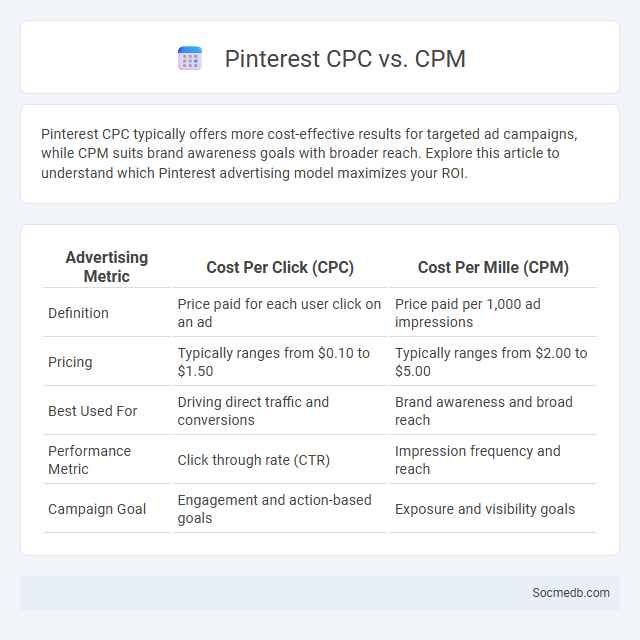
Photo illustration: Pinterest CPC vs CPM
Pinterest CPC typically offers more cost-effective results for targeted ad campaigns, while CPM suits brand awareness goals with broader reach. Explore this article to understand which Pinterest advertising model maximizes your ROI.
Table of Comparison
| Advertising Metric | Cost Per Click (CPC) | Cost Per Mille (CPM) |
|---|---|---|
| Definition | Price paid for each user click on an ad | Price paid per 1,000 ad impressions |
| Pricing | Typically ranges from $0.10 to $1.50 | Typically ranges from $2.00 to $5.00 |
| Best Used For | Driving direct traffic and conversions | Brand awareness and broad reach |
| Performance Metric | Click through rate (CTR) | Impression frequency and reach |
| Campaign Goal | Engagement and action-based goals | Exposure and visibility goals |
Introduction to Pinterest Advertising Models
Pinterest advertising models include Promoted Pins, which seamlessly integrate into users' feeds, enhancing product visibility and engagement. Tailored targeting options such as interest, keyword, and demographic targeting help advertisers reach specific audiences effectively. The Cost-Per-Click (CPC) and Cost-Per-Impression (CPM) pricing models provide flexibility for campaigns aimed at driving traffic or brand awareness.
What is Pinterest CPC (Cost Per Click)?
Pinterest CPC (Cost Per Click) refers to the amount advertisers pay each time a user clicks on their promoted Pin, making it a crucial metric for managing ad budgets effectively. Understanding Pinterest CPC helps you optimize your campaigns by targeting the right audience and adjusting bids to maximize return on investment. Lower CPC rates often indicate better ad relevance and engagement, directly impacting your overall social media marketing performance.
Understanding Pinterest CPM (Cost Per Mille)
Pinterest CPM (Cost Per Mille) represents the cost advertisers pay for one thousand ad impressions on the platform, providing a critical metric for budgeting and campaign performance analysis. Understanding Pinterest CPM involves analyzing factors such as audience targeting, ad format, and competition, which directly impact the cost efficiency of marketing efforts. Leveraging insights from Pinterest CPM data enables businesses to optimize ad spend, improve reach, and maximize return on investment within niche visual discovery and shopping communities.
Overview of Pinterest Paid Promotion Options
Pinterest offers diverse paid promotion options including Promoted Pins, Video Pins, and Shopping Ads, designed to increase brand visibility and engagement. Promoted Pins blend seamlessly with organic content, targeting users based on interests, demographics, and search behavior to drive traffic and conversions. Video Pins and Shopping Ads enhance interactive engagement by showcasing dynamic content and direct product purchases within the platform.
CPC vs CPM: Key Differences on Pinterest
Pinterest advertising offers two primary pricing models: Cost Per Click (CPC) and Cost Per Mille (CPM). CPC charges you only when users engage by clicking on your ad, making it ideal for driving targeted traffic, while CPM charges per thousand impressions, focusing on brand awareness. Understanding these distinctions helps optimize your budget to meet specific campaign goals on Pinterest.
Benefits of Using CPC Campaigns on Pinterest
Pinterest CPC campaigns drive targeted traffic by allowing precise audience segmentation based on interests, demographics, and behaviors. Your ads gain increased visibility through cost-per-click bidding, ensuring you only pay for engaged users, which improves ROI and campaign efficiency. Leveraging Pinterest's visual platform boosts brand awareness and conversions by capturing users actively seeking inspiration and products.
Advantages of CPM Advertising on Pinterest
CPM advertising on Pinterest offers precise audience targeting, allowing brands to reach users based on interests, demographics, and behaviors, which enhances campaign efficiency and relevance. High engagement rates on Pinterest, driven by visually inspiring content, contribute to improved ad performance and increased brand visibility. This platform's cost-effective CPM model enables businesses to maximize return on investment by controlling ad spend while driving traffic and conversions.
When to Choose Paid Promotion Over CPC/CPM
Paid promotion on social media is ideal when targeting specific demographics or achieving immediate visibility is crucial, as it ensures content reaches a defined audience efficiently. Choosing paid promotion over CPC (Cost Per Click) or CPM (Cost Per Mille) campaigns is beneficial when brand awareness needs rapid growth or when organic reach is limited due to platform algorithms. Businesses seeking measurable ROI with predictable costs often favor paid promotion for campaign scalability and precise budget control.
Pinterest CPC vs CPM: Which Drives Better ROI?
Pinterest CPC (Cost Per Click) campaigns typically offer more precise ROI tracking by charging based on actual user engagement, making it easier to measure performance against your budget. CPM (Cost Per Mille) campaigns, charged per impression, can boost brand visibility but may result in higher costs without guaranteed clicks. Understanding which model aligns with your marketing goals helps optimize ad spend and maximize your ROI on Pinterest.
Best Practices for Optimizing Pinterest Ad Spend
Maximizing your Pinterest ad spend involves targeting high-intent keywords and using rich, visually appealing Pins that resonate with your audience's interests. You should leverage Pinterest Analytics to track performance metrics like click-through rates and conversions, refining your campaigns for better ROI. Consistently testing different ad formats and audience segments ensures your budget is spent efficiently and drives meaningful engagement.
 socmedb.com
socmedb.com